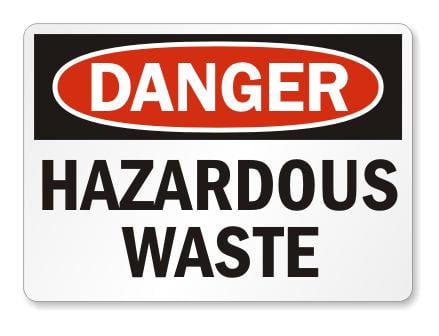What Is Hazardous Waste?

By Joan Whetzel
Hazardous waste comes in all forms - liquids, solids, and occasionally gases - which can be dangerous to humans and to the environment. Items deemed as hazardous waste are usually categorized and catalogued according to criteria on the US government's four hazardous waste lists. Once catalogued and categorized, the items are labeled prominently with a sign listing their flammability, corrosiveness, and their reactive or toxic traits.
Hazardous Waste Categories
There are four lists cataloging the specific categories of hazardous waste: the F-list, K-list, P-list and the U-list (jointly), and the M-list. Items on each list cover the following general types of waste:
· F-list: general manufacturing and industrial waste (e.g. solvents).
· K-list: petroleum, refining, and pesticide waste.
· P-list and U-list: discarded waste from commercial and chemical products, which may be used or unused.
· M-list: waste products containing mercury.
Characteristics of Hazardous Waste
Hazardous waste will have one or more of the following characteristics: ignitability, corrosivity, reactivity, or toxicity. They are considered "waste" because nobody has a use for them anymore and are being discarded.
· Ignitability: any hazardous waste product that, under certain conditions, burns, explodes, or reaches a flash point at temperatures below 140 degrees Fahrenheit (60 degrees Celsius)
· Corrosivity: any hazardous waste products that include acidic or basic solids, or that produce acidic or alkaline liquids which will erode metal containers.
· Reactivity: any hazardous materials that - when heated, compressed, or mixed with water - will explodes or discharges poisonous gasses.
· Toxicity: any hazardous waste product that is either harmful or causes death if swallowed or absorbed through the skin.
Recycling Hazardous Wastes
Some hazardous materials are recyclable, or may be recycled into something else.
· "Spent materials" have become contaminated during use or have run their course (reached the end of their shelf-life), and are considered exhausted as a result.
· "Sludges" are the residue that remain in water vapor and air pollution control devices when these devices have reached their limit.
· "Slag" and other industrial or mining bi-products remain once the materials production process is over.
· "Commercial Chemical Products" are the chemical products that weren't used during manufacturing and remain in their pure state.
· "Scrap metal" are the bits and pieces of metal that can be combined with bolts or solder making them recyclable.
Disposing of Hazardous Waste
· "Use Constituting Disposal" indicates that the hazardous waste will be disposed of by placing it on land or by burning it.
· "Burning for Fuel or Energy Recovery" is a form of hazardous waste disposal that incinerates the waste in a furnace or concrete kiln, or that is burned as a means of heating boilers.
· "Reclamation" is way of treating hazardous waste (i.e. spent nuclear fuels) to recoup some of the material which is deemed valuable.
· A "Generator" is a person, an organization, or a company that produces the hazardous waste.
· "Destination Facilities" are locations that deal with hazardous waste, either proper disposal or through recycling.
· "Transfer Facilities" are the staging areas where hazardous waste can be stored for no more than ten days prior to being hauled to its final destination.
Hazardous Waste Storage
Hazardous waste storage is a means of holding the waste products temporarily before they are treated, properly disposed of, or permanently stored somewhere else. Hazardous waste storage must follow government regulations.
· A number of Containers are used for hazardous waste storage, transport, treatment, disposal, and materials handling. The most common containers are tankers, trucks, railroad cars, buckets, bags, test tubes and 55-gallon drums.
· Drip Pads (wood drying palates) are used by the pressure-treated wood industry to collect excess drippings of wood preservative.
· Containment Buildings are structures which are completely enclosed (4 walls, roof, floor) and self-supporting (not requiring outside intervention to maintain them) and used to store containerized waste.
· Waste Piles are piles of hazardous waste that are open and not enclosed in containers. The piles are used in hazardous waste treatment or storage. They must, however, be placed on a double-liner system to prevent leaching into the soil and ground water.
· Surface Impoundments are surface storage sites formed from natural topographic depressions, in man-made excavated depressions, or in diked areas (e.g. holding pond, storage pits, settling lagoons) which are usually created using earth and lined with synthetic plastic to prevent leaching.
References
California Department of Toxic Substances Control. Defining Hazardous Waste.
http://www.dtsc.ca.gov/HazardousWaste/upload/HWMP_DefiningHW11.pdf
Missouri Department of Natural Resources. Determining a Hazardous Waste.
https://www.dnr.mo.gov/env/hwp/enf/determining-hazardous-waste.htm
US Environmental Protection Agency. Glossary of Regulatory Terms.
http://www.epa.gov/osw/hazard/wastetypes/universal/glossary.htm
Connecticut Department of Environmental Protection. Hazardous Waste.
http://www.ct.gov/dep/cwp/view.asp?a=2718&q=325420&depNav_GID=1646
Fed Center. Hazardous Waste Landfills.
http://www.fedcenter.gov/assistance/facilitytour/landfills/hazwaste/
United States Department of Labor. Hazardous Waste.
http://www.osha.gov/SLTC/hazardouswaste/index.html
EPA. Wastes - Hazardous Waste - Treatment, Storage & Disposal (TSD).





